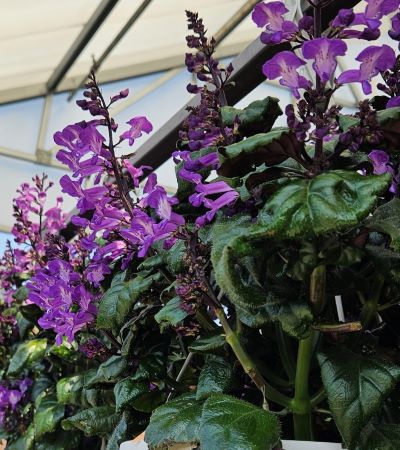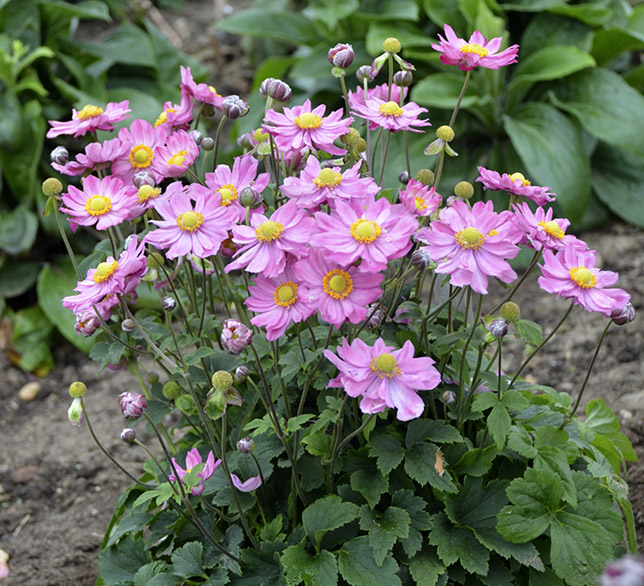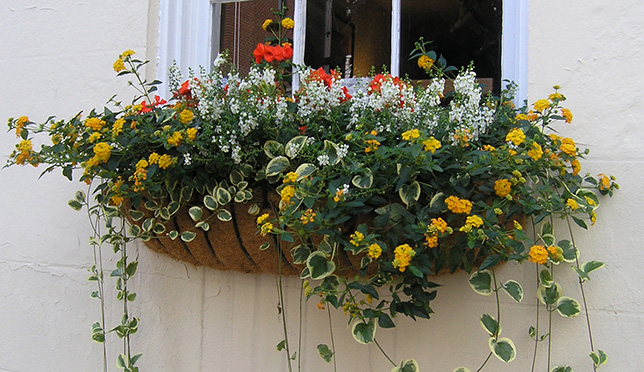Refreshing Container Gardens in Late Summer
Often by the time August rolls around, the window hayracks we planted back in May look a little tired and in need of some help. Three months can be a long time to expect annuals to stay beautiful in a small space while likely having to endure neglected watering, often in combination with extreme summer and humidity. Many of us don’t regularly fertilize, deadhead, or prune our little window gardens either. So, it’s no wonder that we find ourselves wanting to pep up those plantings, especially considering their conspicuous placement at the front of the house.

Late summer plants bridge the gap until fall
Somehow though, it feels too early to give up on summer and change over to a fall display--and some of the plants still look good. Even if we planted the mums that are available earlier and earlier every year, they’d bloom out before autumn even arrives. And garden centers aren’t exactly chock full of healthy, blooming annuals at this point. So, what’s the best strategy for refreshing the window box look this time of year?
We took a trip to several garden centers to help determine exactly that. You’ll probably find similar annuals in most big box stores in a given region—those growers all seem to ride the same bandwagon. You might find better selections at an independent garden center, especially if it’s one that keeps their overstock well-maintained. Plus, you also have the option of choosing some smaller pots of late summer flowering perennials and shrubs. Let’s dig in and see what we found, and give you some suggestions and strategies for a fabulous freshening up.

Annuals & Edibles for Late Summer Plantings
For the last few years, the most common fresh late-summer annuals we’ve seen at the stores are caladiums, coleus, asparagus fern, sweet potato vine, celosia, and calibrachoa (million bells). Other likely possibilities are Mona Lavender plectranthus, wax begonias, portulaca and lantana. Curiously, a lot of these are heat-loving plants that aren’t going to look great once cold weather arrives—sweet potato vine, coleus, caladiums, plectranthus, and celosia will suffer sooner than many others. However, caladium bulbs can be saved and coleus and plectranthus can be overwintered as a houseplant, so that’s something. And the intense yellow, red, and orange hues of many coleus do make a tremendous splash in later summer and blend beautifully in fall combos.
Mona Lavender plectranthus is a striking plant from South Africa, bearing fuzzy dark green leaves with purple undersides and delicate spikes of pale lavender flowers. A “short-day” plant, flowering is initiated and continued under short-day conditions, hence its appearance in late summer. The deep purple color lends a dramatic, mysterious effect to plantings, rendering it a top choice for fall as well. Truly spectacular combined with chartreuse foliage. A magenta flowered form and one with showier blooms, “Magic Mona,” are also available. They can take full sun, but in my experience they usually look better with a little shade. If you see fit to bring this in the house before the frost gets it, it may bloom for you through the winter. In zones 10-11 it is perennial.
Celosia is also a photoperiod sensitive plant, its flowering being increased rather than initiated with shorter days. That’s probably why there’s always a proliferation of them at the garden centers in fall. Two varieities are particularly notable, Intenz and Dragon's Breath. The deep green leaves topped with electric purple spiky blooms on Intenz do make for an exciting appearance. The flowers work well with a fall color palette of orange, yellow, and purple, adding not only intense color but sharp texture. Dragon's Breath boasts bronzy-red foliage with ultra fluffy pinkish-red plumes for a softer but strangely intriguing appeal. Both of these celosias and the Mona plectranthus will bring drama to a Halloween-themed display. They exude an almost spooky ambience that makes for a fun fall planting sure to delight both children and adults.
Almost every store, box or independent, still had a good supply of healthy, happy, blooming mandevilla, from 5-inch pots to 10 inch hanging baskets to 6-foot specimens on bamboo tepees—many on sale, as they had been there a while. They were by far the most attractive “annuals” we found, so I think that tells us what we could be planting next spring that will last nicely through the summer. Most were red, but there were a few peach colored beauties which will look less summery as we move into fall.
Another readily available, interesting, and colorful plant was curcuma, a flowering ginger, available from several shops. You might find a few different types now, as these seem to be on the increase with growers. Some are considered tumeric, some ginger, and some bear the common name of Siam Tulip, although they look nothing like tulips to me. The unique pine-cone shaped flowers are actually highly modified leaves, or bracts. That's a great feature, because bracts tendto last longer than the actual blooms--like with poinsettias, for instance, prolonging the attractive display. In their native haunts, they experience monsoons in the summer combined with a very dry winter in dormancy, so that should tell you what you need to know. In cold climates the rhizomes can be lifted and stored for winter. In zones 8-11 these are perennial, and although they look like a sun-loving tropical, they prefer some shade, as do many gingers. They'll bloom in summer or fall and come up very, very late in spring. If overwintering rhizomes indoors you may want to start them with your seeds, several weeks before your last frost date, or you'll be waiting a while.
On our trip, we did find a bit of remaining flowering vinca, impatiens, pentas, Mexican heather (cuphea), and even some very well cared for evolvulus (blue daze) (on a big box store clearance cart, no less). Go for the brightest colors you can, as late summer sunlight will wash out pastels and leave your boxes looking blah. If your planting gets mostly morning sun then pale colors will be better highlighted and can be blended with white or purple mums, asters, or kale for a soft fall look when the time comes.
Sadly lacking were some of the things we depend on for color in containers, like petunias and verbena—especially for vibrant purple and blue shades. These are good candidates if you come across them, as they tend to be less cold sensitive and will hang around longer than other heat-loving annuals. Cool weather tolerant annuals like dianthus, osteospermum (Cape daisy), diascia and nemesia will last longer into the fall, so grab these if you find them. Osteos come in gorgeous sunset colors perfect for a summer into fall display—corals, oranges, and purples. Even if available, pansies and violas really shouldn’t be added until cooler weather prevails, as they’re likely to get leggy quickly in the heat—try to wait to purchase these if you can.
One other option is to use herbs and fall vegetable transplants. Plants with colorful foliage like Bull's Blood beets, Rainbow Swiss chard, chartreuse or red leaf lettuces, rumex, Icterina golden sage, tri-color sage, and golden or variegated thyme or oregano tolerate cooler weather and are easy to grow in mixed containers. Chives,dill, and parsley provide pleasing leaf textures. And then you get to eat them, too, of course.
Perennials for Late Summer Container Gardens
Every store had nice pots of 1 gallon rudbeckia, coneflowers, sedum, ferns, and ornamental grasses, and at least one variety of heuchera. Barring those there was not much consistency, with blooming salvia, phlox, coreopsis, kniphofia, and gaillardia at various box store locations. The independents really shined here, with well-stocked and well-cared for plants including plenty of natives. Perennials in flower included many more varieties of coneflower and rudbeckia, veronica, salvia, phlox, balloon flower, yarrow, agastache, chelone (turtlehead), helenium, gaillardia, and monarda. Plenty of grasses, ferns, and variously colored heucheras rounded out the selections.
The seedheads of coneflowers and rudbeckia can make an attractive display mixed with small grasses like carex and blooming mums or asters and ornamental peppers later on, so that can extend their usefulness. Upright sedums bloom late and will have long-standing dried flowerheads, and many trailing varieites are colorful and evergreen. Heucheras are invaluable for their range of foliage colors from subtle peach and silver to bold burgundy, red and chartreuse, and their foliage should stay attractive well into the winter. For more long-lasting foliage, look to tassel fern, christmas fern, and holly ferns.
Most grasses, too, will have ornamental value even after frost. Evergreen species of carex are a great choice, adding a fine texture and subtle color by way of varying amounts of yellow or white linear variegation. Bronze carex that might look odd the rest of the year come into their own in late summer and fall, complementing strong burgundy, red, pink, and orange toned mums as well as the gentle blues of asters. You'll find a lot of one gallon pots of grasses, and even though in the ground they might grow to 3 feet in height or more, their size will be restricted in a container--at least for a while! Just about any ornamental grass will look good as long as the height is in proportion to both your window box and the other plants. Come fall, they'll lend the perfect autumn feel to your arrangement.
Shrubs for Late Summer Container Gardens
So many small, compact shrubs are being bred now that it’s worth a visit to the woodies department when you’re designing a container garden. Compact buddleias and crape myrtles top the list for summer bloomers and were consistently available in smaller pots. Small conifers are easily found and make excellent year-round container plants, especially blue star and blue pacific juniper, and dwarf green or golden arborvitae selections. One-gallon pots of abelia will add exciting texture and foliage color in addition to their white or soft pink flowers. If you just need some greenery you can choose from small boxwoods or narrow, upright Japanese hollies.
Ground Covers for Late Summer Container Gardens
For containers, this translates to trailing plants. Ajuga, vinca vine, sedums and various types of English ivy were present everywhere. In warmer zones you may also find dichondra or Asiatic jasmine. Evergreen groundcovers are excellent as year-round container components.
Ajuga is a nice option, as it bears attractive blue flower spikes in spring/summer and is quite low maintenance. The plant has undergone much recent breeding, resulting in new foliage color combinations of chartreuse, yellow, gold, and orange, many with very small leaves, some with pink flowers. Look for the 'Feathered Friends' series, or stick with tried and true 'Black Scallop,' 'Chocolate Chip,' or 'Burgundy Glow.'
You’re likely to find some more interesting English ivy these days, with more finely textured foliage and white or yellow variegation to spice things up a bit. Although invasive, when kept in a container English ivy is fairly safe. If it doesn’t reach the ground to root it can’t spread, and if it doesn’t climb it won’t fruit, so can’t propagate itself from seed. You’ll just need to be sure it doesn’t attach itself to brick walls or wooden surfaces.
Don’t count out liriope, especially the variegated ones. As ubiquitous as it may be, sometimes it’s just the thing when a design seems to be lacking. The spot of color and flowing, grassy texture quietly support and uplift the other elements. And it’s evergreen, ridiculously easy to grow, cheap, and has pretty purple or white blooms. You can probably yank a bit out of your garden for free—even better! If you're buying anew, just be sure to grab a muscari species and not a spicata--Liriope spicata sends runners everwhere and will not play nicely with its friends, whereas Liriope muscari is a well-behaved clumping type.
Tips for Refreshing your Container Gardens in Late Summer
The first thing to decide is which plants you want to keep and which ones need the heave-ho. If annuals are just out of bloom, try fertilizing first, and trimming back if there are no buds. If some plants are blooming but leggy or bare at the bottom, you might be able to add something bushy to hide that, like asparagus fern or a cloud of annual white euphorbia. Make a note to prune these plants back next year to avoid the problem.
To make room for new plants, locate the crown of the plant you are removing and using a knife, cut all the way around the crown down to the bottom to create a hole large enough for your new plant. If your remaining plants are very large or long you should keep an eye on them for signs of wilting after the “procedure.” Usually they will be fine, but sometimes you must make a shoot to root ratio adjustment as some of their roots will be removed also. You won’t need a lot of room for an annual, as the plants won’t be in there that long.
If you’re adding a perennial or shrub that you’d like to overwinter in your container garden you would be well to give it some space to establish a better root system. On the other hand, if you want to plant it in another part of the garden in fall, you can plop the plant in pot and all. It will root a bit through the holes but will be much easier to remove when you’re ready. If the pot is thin enough you can also cut some slits in the sides. If it’s hard plastic you can either cut the bottom of the pot off or enlarge the holes a bit with sharp pruners or metal snips. This can help prevent root rot if the plant gets overwatered. Remember to water inside the rim of the pot when watering or it won’t get enough!
We saw a lot of pre-planted combos that were fresh and pretty but didn’t match size and shape we needed. Most of these are in round pots, which makes it difficult to use them in narrow window boxes and hayracks. But if you find something you love, there’s no reason not to give it a shot with some clever cutting. Again, simply locate the crown of the plants so you don’t damage them, and cut the plants apart between the crowns, just like slicing a big ol’ cake. You’ll need to know the root structure of things—you wouldn’t want to damage the rhizome of a large elephant ear while slicing out the surrounding plants, for example, and sweet potato vines ARE sweet potatos, so look out down below. Spreading plants like creeping jenny aren’t likely to still have one central crown, so just cut carefully between the stems so you don’t cut them off.
In a combo with a large center plant, you can make one slice at the rear into the middle, and then cut gently halfway around the back of the “thriller.” Stay at least 2 inches away from the crown when cutting. Then you should be able to pull the side pieces toward you to end up with a more or less linear arrangement instead of a circle. A 12” planter cut this way would nicely fill a 24” window box. Again, any very large or long plants that have had their roots disturbed will need to be watched carefully and may need a trim to accommodate the reduced root structure. But trust me, most of the time this works like a charm. When doing “drastic” things like this, it’s a good idea to shade the plants from hot afternoon sun for about a week to allow them to recover. Plants are incredibly resilient—much more than we give them credit for, when properly planted, watered, and fed.
If you are starting over completely but still want to do a seasonal changeout for fall, you can plan ahead for that. In this case you don’t want to overstuff the planters—as long as everything is fresh you can space plants out more and leave room for your fall color—it will still look better than packed with old, tired annuals. You could loosely fill with vibrant chartreuse coleus and dark-leaved Mona Lavender plectranthus with a trailing yellow-variegated ivy, leaving space to add small orange mums later on, for instance. Or try a bright foliaged abelia with Intenz celosia and chartreuse ajuga, and when it turns cold replace the celosia with purple kale and perhaps a few orange pansies.
Even just one caladium or coleus and a couple of asparagus ferns will do the job for a while, creating an attractive backdrop for your fall plants once they're ready. Just leave space where you'll want to add your ornamental peppers, mums, asters, etc. and you'll be able to do your fall display in a jiffy. Gorgeous foliage plants like coleus, ferns, heucheras, ivy, ajuga, carex and others provide an easy to grow base planting that should last the entire season, needing only a little trimming here and there. With those in place, if your blooming plants take a nose-dive you have a lot less to replace. A little planning ahead can save a lot of valuable time and money and keep your curb appeal in top-notch shape.
Share a pic of what's in your window hayrack--you may inspire another gardener to greatness!!






























